You can search and browse the collection in the State of Massachusetts’ DSpace online repository here.
In this post I’m going to answer common questions about the best strategy for creating and maintaining your family tree data.

This is a question I get in various forms quite often from Genealogy Gems Podcast listeners. But there’s really more to this question than meets the eye. Today’s family historian needs a master game plan for how they will not only build their family tree, but where they will build it, and where they will share it.
On the podcast I describe it this way:
Plant your tree in your own backyard and share branches online.
I’m going to explain what I mean by this by starting at the beginning.
If you’re new to researching your family’s history, you probably started out with one of the big genealogy websites, such as Ancestry, MyHeritage, Findmypast, or FamilySearch. I refer to them as the Genealogy Giants because they have millions of genealogical records, and they offer you the tools to build your family tree on their website. (Learn more about what each of the Genealogy Giants websites have to offer here in this handy comparison guide.)
These sites make it easy to start entering information about yourself, your parents, and your grandparents either on their website or through their mobile app. But should you do that?
My answer is, “not so fast!” Let’s think through the long-term game plan for this important information that is your family’s legacy.
Genealogy is a hobby that lasts a lifetime. It’s nearly impossible to run out of ancestors or stories to explore.
But have you noticed that websites don’t last forever? And even if they do, their services and tools will undoubtedly change over time.
And there are many, many genealogy websites out there. A large number of them will encourage you or even require you to start creating an online family tree on their site in order to get the most value from the tools that they offer for your research.
As you work with these different genealogy websites, you may start to feel like your tree is getting scattered across the web. It’s easy to find yourself with different versions of your tree, unsure of which one is the most accurate and complete version.
It’s this inevitable situation that leads to my conclusion that you build and protect a master version of your family tree. I’m not suggesting that you can’t or shouldn’t use an online tree. In fact, regardless of whether you do, you need a “Master Family Tree.”
What do I mean when I say that you should plant your “master family tree” in your own backyard? I’m talking about using a genealogy database software program that resides on your own computer. Let’s explore that further.

Your Master Family Tree
If you create an online family tree on a genealogy website (or in the case of FamilySearch’s global online tree, you add your information to it) you have given final control of that information to the company who owns the website.
In order to own and control your tree, you will need a genealogy database software program installed on your own computer. I use RootsMagic (and I’m proud to have them as a sponsor of the Genealogy Gems Podcast) but there are other programs as well.
A genealogy database software program is installed on your computer. The program and the data you enter into it belongs to you and is under your personal control.
Genealogy databases allow you to not only easily enter data, but also to export it. If you wish to use a different program later, or add your existing data to an online tree, you can export your family tree data as a universally accepted GEDCOM file. (Learn more about GEDCOM files in this article.)
As you research your family tree, you will come to important conclusions, such as an ancestor’s birthdate or the village in which they were born. It can take a while to prove your findings are accurate, but once you do, you need one location in which to keep those findings. And most importantly, you must be able to cite the sources for that information. That one location for all this activity is your genealogy database.
However, the nature of genealogy research is that it can take some digging to prove the information is correct. During the process of that research you may find information that you aren’t sure about, and it can be helpful to attach it to the online tree that you have at the same website where you found the information. That gives you a way to hang on to it and keep researching. You can always remove it later. We’ll talk more about strategies for using online family trees a little bit later.
Once you are convinced that the information is correct, then its final resting place is your Master Family Tree. You enter the information and add source citations. This way, whenever you need an accurate view of where you are in your completed family tree research, you can turn to one location: your genealogy database software and the Master Family Tree it contains.
Your family tree isn’t safe unless the database file is backed up to the cloud.
Who among us hasn’t had a computer malfunction or die?
It isn’t good enough to simply back up your computer files to an external hard drive, because that external hard drive is still in your house. If your house is damaged or burglarized, chances are both will be affected.
Another problem with backing up to an external hard drive is that they can malfunction and break. And of course, there is the problem of remembering to back it up on a regular basis.
Cloud backup solves all these problems by backing up your files automatically and storing them safely in an offsite location.
Cloud backup is actually very simple to install and requires no work on your part once it’s up and running. (We’ve got an article here that will walk you through the process.)
There are many cloud backup services available. I use Backblaze (which you can learn more about here). As a genealogist I have a checklist of features that are important to me, and Backblaze checked all the boxes.
Regardless of which service you choose the important thing is to not wait another day to set it up. This protection is a critical part of your Master Family Tree plan.
Now that you have your own database on your own computer that is backed up to the cloud for protection, let’s talk about strategic ways that you can use online family trees.
First, it’s important to realize that you don’t have to create a tree on a genealogy website just because they prompt you to do so. While there are benefits for you to doing so, the company who owns that website actually benefits tremendously as well.
In today’s world, data is very valuable. I encourage you to read the terms of service and other fine print (I know, it’s boring!) because it will explain the ownership and potential use of that data.
While it’s not the focus of this article, it’s important to understand that other industries are interested in family history data, and data may be shared or sold (with or without identifying information, depending on the terms).
But as I say, there are benefits to using online family trees. These benefits include:
These benefits can be helpful indeed. However, problems can arise too. They include:
So, let’s review my strategy:
Plant your tree in your own backyard and share branches online.
Now that you’ve planted your tree in your own backed up software, let’s explore the ways in which you can share branches online.
Many people don’t realize that you don’t have to add your entire tree to a website. You can just add parts of your tree.
For example, I may just put my direct ancestors in my tree (grandparents, great-grandparents, and so forth). This can still be a fairly larger number of people. I may want to include their siblings because they grew up in the same household. But I can leave out the far-reaching branches and relatives that really don’t have a direct impact on that line of research.
You can also have multiple trees that focus on specific areas of your research that are important to you.
Some genealogists also create trees that represent a working theory that they have. This type of tree can help expose where the problems or inaccuracies lie. As you research the theory and as hints arise it can become very clear that a relationship does not exist after all.
An exploratory tree is an excellent reminder that we can’t and shouldn’t make assumptions about someone’s intent or purpose with their online tree. I’ve heard from many people who are angry about inaccuracies they find in other people’s trees. But we can’t know their purpose, and therefore, it really isn’t our place to judge.
However, it is a fair argument that a good practice would be to clearly mark these exploratory trees accordingly to deter other users from blindly copying and replicating the inaccurate information. An easy way to do this is in the title or name of the tree. For example, a tree could be titled “Jonas Smith Tree UNPROVEN”.
Creating multiple, limited trees can be an effective strategy for conducting targeted online research that only generates hints and connections for those ancestors that you are interested in at the current time.
And remember, you can remove any of your trees at any time. For example, you can delete an exploratory tree that has served its purpose and helped you prove or disprove a relationship.
A family tree can seem like a simple thing, but as you can see there’s more to it than meets the eye. A bit of planning now can ensure that your family tree stays healthy and growing.
Lisa Louise Cooke is the Producer and Host of the Genealogy Gems Podcast, an online genealogy audio show and app. She is the author of the books The Genealogist’s Google Toolbox, Mobile Genealogy, How to Find Your Family History in Newspapers, and the Google Earth for Genealogy video series, an international keynote speaker, and producer of the Family Tree Magazine Podcast.
Disclosure: This article contains affiliate links and Genealogy Gems will be compensated if you make a purchase after clicking on these links (at no additional cost to you). Thank you for supporting Genealogy Gems!
Topping the list of new and updated genealogy records this week are United States military records. Ancestry.com has a new collection of U.S. Navy Muster Rolls and an updated collection of historical postcards. Enjoy a special interview with military expert Michael Strauss on how he solved an old postcard mystery! Also new this week are WWI U.S. records at FamilySearch for Michigan and Utah, which you can access for free online.
Ancestry.com has a new collection of U.S. Navy Muster Rolls, 1949-1963. From the description:
Ancestry.com also recently updated their collection of U.S. Historical Postcards, 1893-1960. You might be wondering how historical postcards would be valuable to your genealogy research. The collection description sheds some light on what you can use this database for:
“This database contains over 115,000 historical postcards with photos of places in the United States. Each postcard caption has been indexed and may be searched by keyword or location. The database also includes the city, county, state, and postcard era (estimated year range) for most postcards.
This database is primarily useful for obtaining a photograph or picture of a specific place in time. If you do not already have pictures of the places your ancestors lived, historical postcards are a good alternative to personal photos.”
In the video below: A captivating story unfolds of old postcards from WWI that are snatched from oblivion by Michael Strauss, who is the Genealogy Gems Podcast Military Minutes man. Michael shares the story of how he found the historic postcards on eBay, and the research process he followed to identify their author. These are strategies that you can use in many areas of your family history research!
You can explore even more new WWI records for genealogy thanks to FamilySearch’s newest additions to their free records.
These records may help you find out more about your ancestors who served in the military during WWI. Depending on the collection and record, you might find:
If you don’t find the person you’re looking for, FamilySearch has these helpful suggestions for next steps:
Michael Strauss is our resident Military Minutes man for The Genealogy Gems Podcast. He first debuted on the show on episode #207, where he talked about draft registrations. Click here to listen to the episode and download an exclusive free 4-page handout! For more expert military research tips and insight, browse Michael’s many articles on our website by clicking here.
About the Author: Lacey Cooke has been working with Genealogy Gems since the company’s inception in 2007. Now, as the full-time manager of Genealogy Gems, she creates the free weekly newsletter, writes blogs, coordinates live events, and collaborates on new product development. No stranger to working with dead people, Lacey holds a degree in Forensic Anthropology, and is passionate about criminal justice and investigative techniques. She is the proud dog mom of Renly the corgi.
Disclosure: This article contains affiliate links and Genealogy Gems will be compensated if you make a purchase after clicking on these links (at no additional cost to you). Thank you for supporting Genealogy Gems!
There has always been something mysterious about cemeteries. Perhaps the knowledge that those interred took secrets to their grave has resulted in the enigmatic haze that seems to linger over these peaceful resting sites. But it’s not just the dead that hold secrets. Cemeteries themselves are often home to puzzling (and sometimes spooky) features.
Joy Neighbors, author of the book The Family Tree Cemetery Field Guide shares three of her most shocking finds while scouring cemeteries for genealogical clues.
We think of cemeteries as quiet tranquil places. As a “Tombstone Tourist,” I’ve spent years in cemeteries searching for genealogy clues, exquisite artwork, stunning vistas, and that perfect photograph. A trip to the graveyard is never boring. I’ve come back with tales of beauty, delight, and terror. Here are just three shocking discoveries I’ve made while searching in cemeteries.
There’s a cemetery in Kentucky that holds a baffling find; three 19th century mausoleums that have disappeared right in the middle of the grounds.
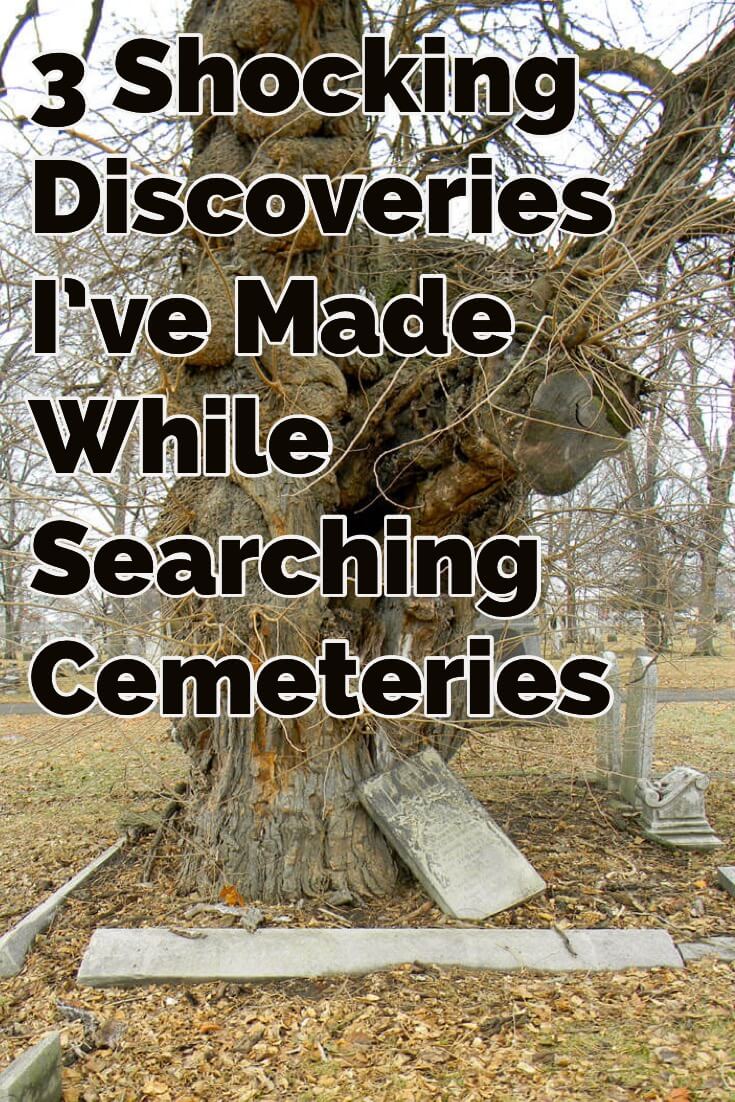
On a humid July day, I stepped inside a grove of trees to escape the searing heat. Inside that cool dimness stood three stately mausoleums, each with a façade protruding from a hill now enveloped in trees, vines, and shrubs. This thicket had been growing untamed for years.
The mausoleums stood side-by-side. The first was a small brick crypt with a surname above the entry along with a date “1895.” But the tomb had been bricked up for so long, trees grew on top obscuring its existence.
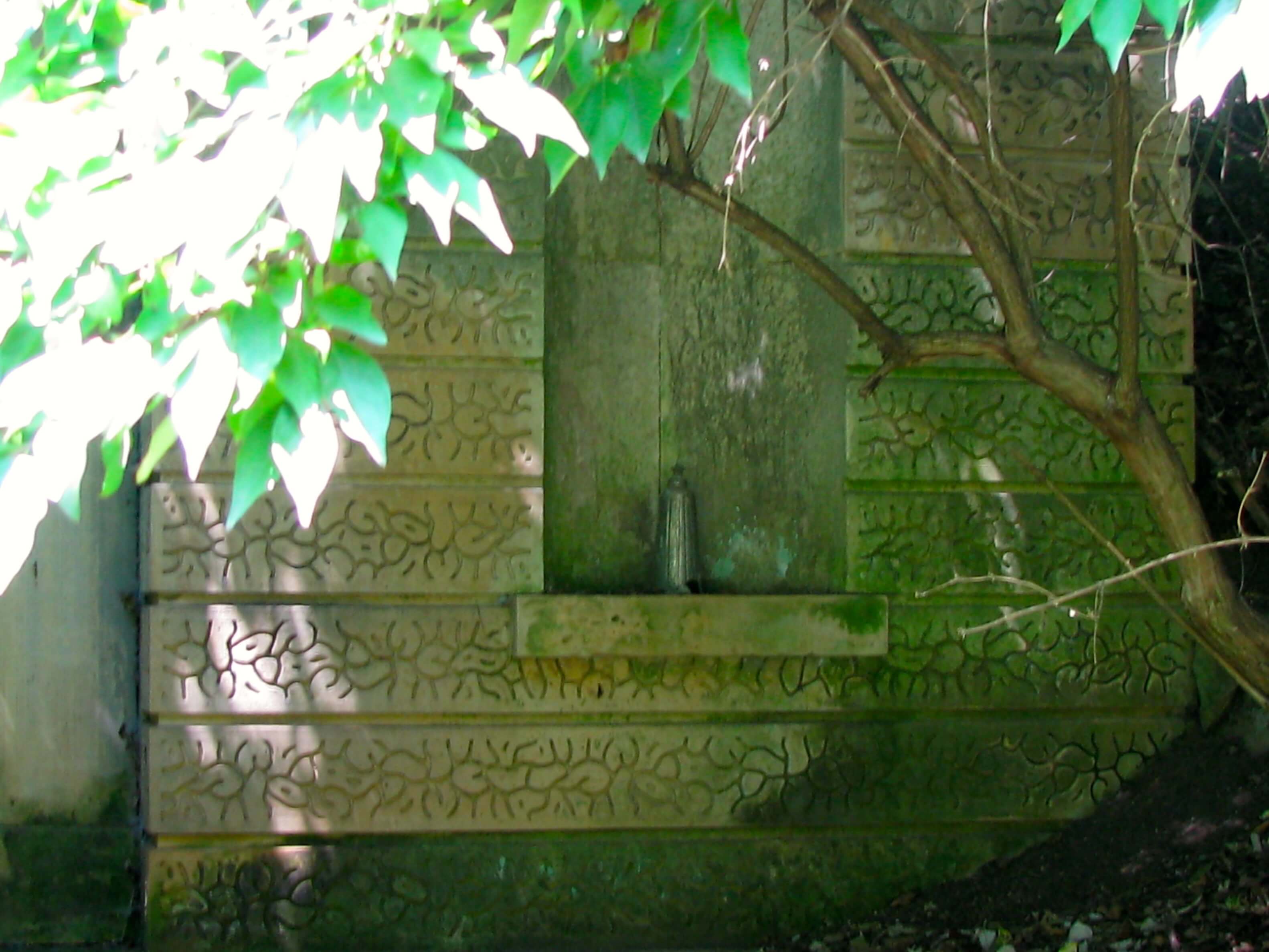
The middle mausoleum was built from pressed concrete with niches and arches along the walls. Again, the doorway and windows were bricked shut against the onslaught of trees and ropy vines that brushed and clung to its surface.
The third mausoleum was constructed of plainer concrete set off in a corner. No names or dates were visible but trees blocked any approach. It was visible only through a tangle of vines and foliage.
Who had these monuments been for?
Why had they been abandoned?
Had the bodies been moved when family members relocated?
Or were they simply forgotten?
Perhaps no one left payment for special care in perpetuity.
Apparently, what has been lost and forgotten shall remain so.
Having grown up in Indiana, I can assure you that Hoosiers are a practical lot. But there’s one roadside attraction that will cause the most stoic of residents to stop and ponder the audacity and fortitude it took to keep a grave in the middle of the road for close to 200 years.
The story began in 1808 when Nancy Kerlin married William Barnett, the great, great, great grandson of Pocahontas and John Rolfe.
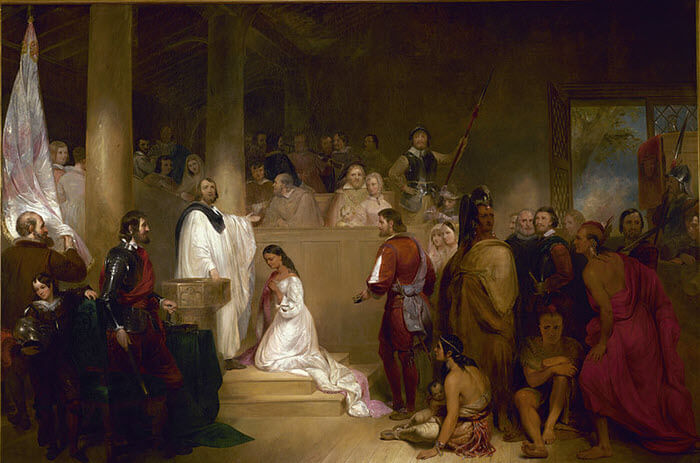
Baptism of Pocahontas by John G. Chapman, 1840. (Public Domain Image)
They settled near what would become Amity, Indiana to raise their family.
Nancy died on December 1, 1831 and was buried on top of a small hill overlooking Sugar Creek, one of her favorite spots. Soon others were also buried here and over the years a small county cemetery developed.
But then progress reared its head around the turn of the last century and Johnson County decided that a road needed to be built to connect Amity with other thoroughfares. This meant the grave had to be relocated.
Nancy’s grandson, Daniel G. Doty had a problem with that.
Doty went to the county and voiced his opposition. Nothing changed so he decided to take matters into his own hands. When county work crews arrived they found Doty sitting on his grandmother’s grave – with a loaded shotgun. Again, Doty told the county that his grandmother would stay where she was. If they insisted on trying to move her grave, they would have to deal with him. With that prospect, county workers agreed to let things “rest” where they were.
A concrete slab was placed over the grave in 1912 to protect it.
An historical marker was added in 1982, and Nancy became an anomaly.
But three years ago, after numerous reports of accidents, something had to be done.
In 2016, Nancy’s grave was temporarily moved to widen the road. It was the perfect time for University of Indianapolis archaeologists to see just what was buried there.
Amazingly, they discovered that residents have been driving past not only Nancy’s grave but also the remains of six others – a man, a woman and four children. Was this the Barnett family? No one’s said for sure but the state has now designated this small spot in the middle of the road a family cemetery.
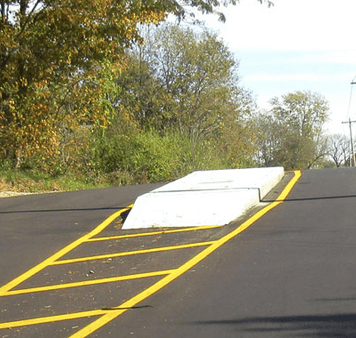
The Grave in the Middle of the Road
In Terre Haute, Indiana there stands the most massively disfigured cemetery tree I’ve ever encountered. Though its genus is no longer identifiable, it stretches at odd angles as if reaching out in despair.
It was a frigid January day when I encountered what I have since called “The Tree of the Dead.”
I’d been taking photos when my husband waved me over to see his find. Over the years I have seen hundreds of ominous cemetery trees, but none like this. This tree was surely waiting for the headless horseman to plunge through that opening with a rush of fetid air as he continued searching for his head.
Stepping closer, I attempted to take a photo, but the tree was having none of it. My camera shut down immediately. There are several explanations for this common cemetery occurrence; the batteries are too cold, connections are corroded, post seals are damaged, or spirits are sapping energy attempting to manifest. Yes, well … but after changing the batteries two more times, I had yet to get one picture.
My husband thrust his camera into my hands and I was able to get two photos before the batteries died. One shows the tree in all of its appalling façade with twisted limbs reaching akimbo to the sky. (Notice the limb with a dragon’s head at the end?)
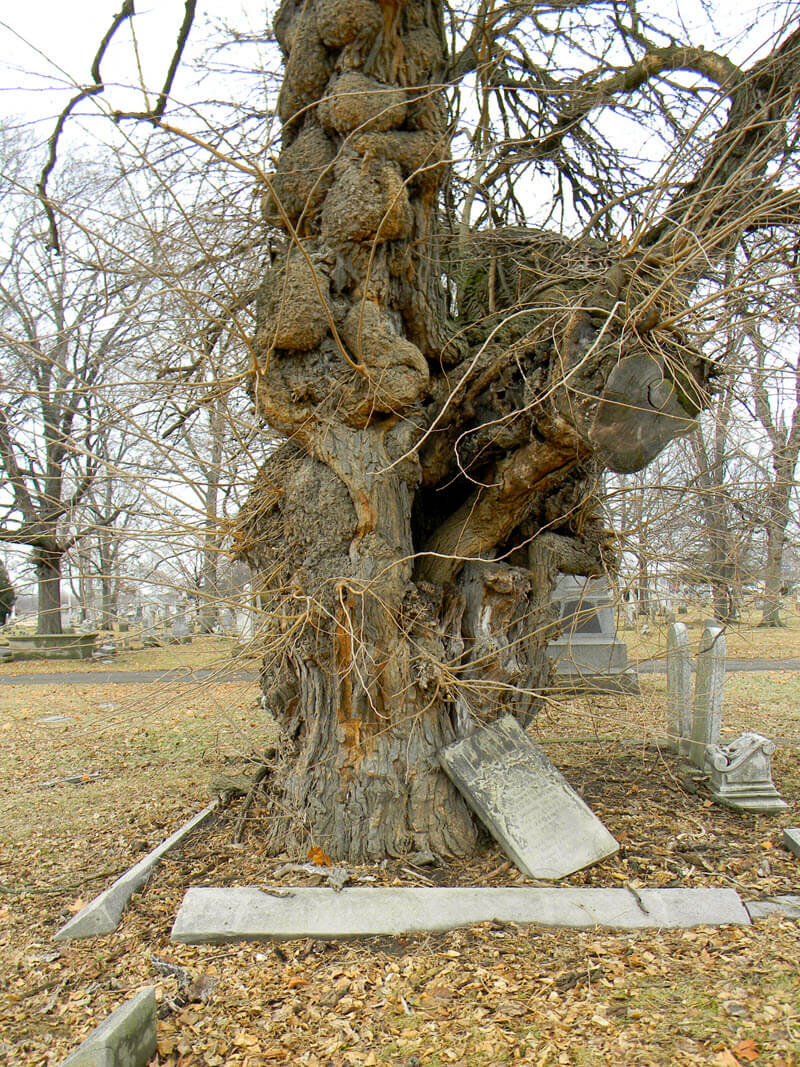 The second shot shows the opening in the middle of the tree: a bizarre heart shape. And the mishmash of tombstones scattered around the plot date to the late 1800s but names are indecipherable.
The second shot shows the opening in the middle of the tree: a bizarre heart shape. And the mishmash of tombstones scattered around the plot date to the late 1800s but names are indecipherable.
Who is buried here?
What happened to give the tree such an appearance?
Could it be caused by a decades-old drought?
Maybe arsenic used to embalm bodies back in the 19th century slowly leaching its way up into the tree?
Or could it be … something else?
A visual reminder of how perilously close fact and fiction are entwined in the graveyard.
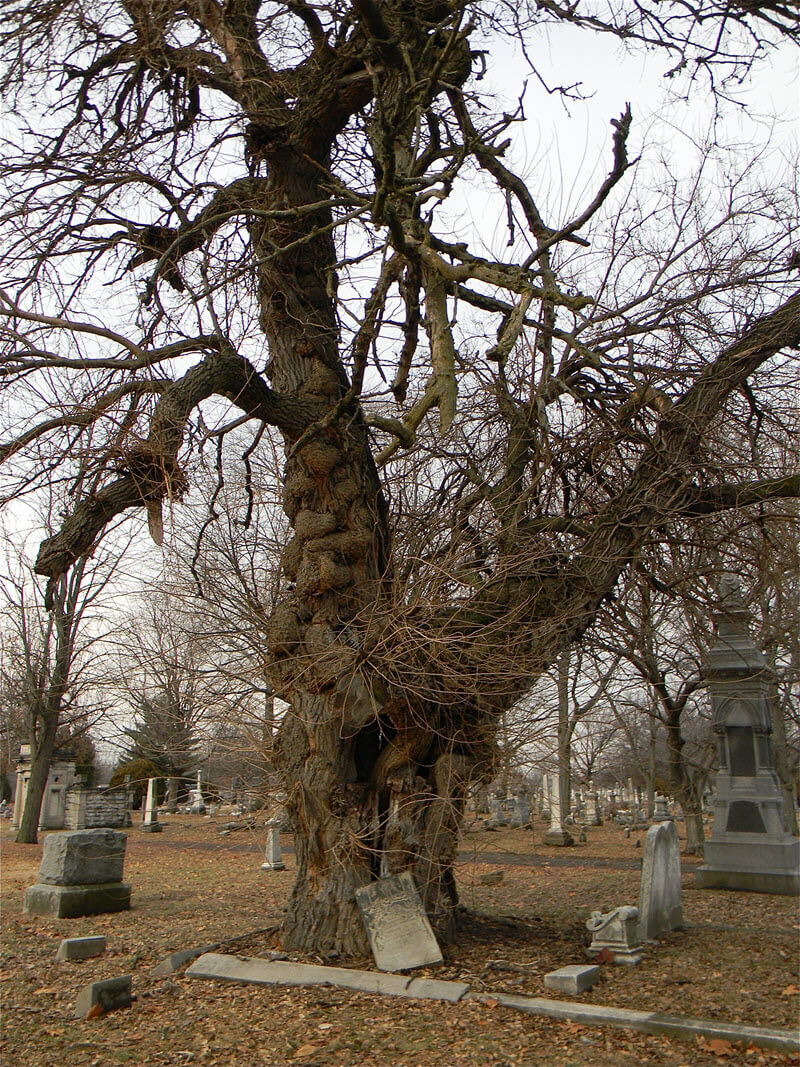
Cemeteries hold a vast amount of secrets, most of which we may never know. But the genealogist’s pursuit of answers means we’ll never stop exploring and asking the questions, and perhaps one day, those secrets taken to the grave may be revealed.
Cemeteries are crucial for any genealogist’s search, and The Family Tree Cemetery Field Guide by Joy Neighbors will show you how to search for and analyze your ancestors’ graves.
Discover tools for locating tombstones, tips for traipsing through cemeteries, an at-a-glance guide to frequently used gravestone icons, and practical strategies for on-the-ground research. And once you’ve returned home, learn how to incorporate gravestone information into your research, as well as how to upload grave locations to BillionGraves and record your findings in memorial pages on Find A Grave.
Click here to order your copy today!
(Click on player to unmute sound)
About the Author: Joy Neighbors is a national speaker, author, freelance writer, blogger, and avowed Tombstone Tourist. Her book, The Family Tree Cemetery Field Guide focuses on how to locate cemetery records, what to do when you get to the cemetery and how to understand the silent language of the stones. She also shares a few stunning family secrets along the way. Joy also writes the weekly cemetery culture blog, A Grave.

Disclosure: This article contains affiliate links and Genealogy Gems will be compensated if you make a purchase after clicking on these links (at no additional cost to you). Thank you for supporting Genealogy Gems!
You’re going to want to make some time in your schedule this week to explore these new genealogy records that just might help you discover a new branch of your family tree! This week we highlight a wide variety of intriguing records including historical maps, oral histories, workhouse records, and historical newspapers. (Disclosure: This article contains affiliate links and Genealogy Gems will be compensated if you make a purchase after clicking on these links (at no additional cost to you). Thank you for helping us bring these free articles to you!)
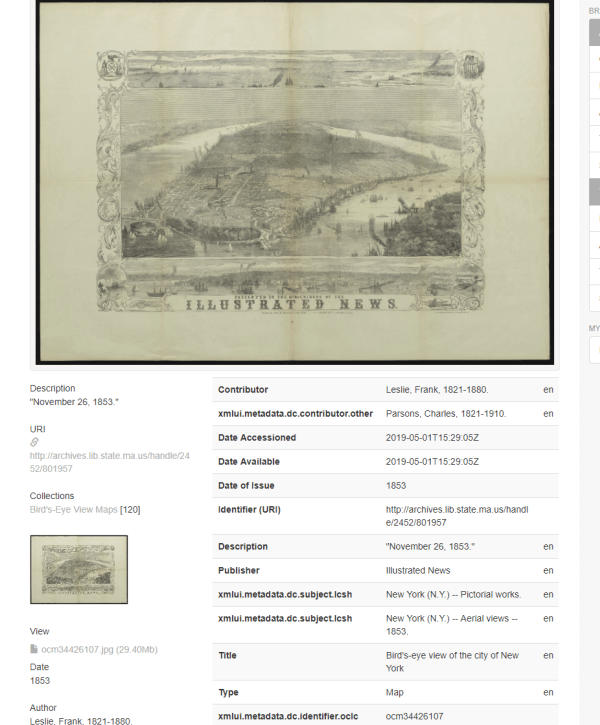
You can search and browse the collection in the State of Massachusetts’ DSpace online repository here.
World War II ended in 1945 making a man who enlisted at the age of 18 that year, 92 years old today. A new digital archive at Bowling Green State University is striving to digitize old cassette tapes and video tapes that contain interviews with over 100 veterans from Ohio.
According to the website, the exhibit “provides full digital access to the History 303 World War II oral histories (MS-0871). The oral histories were collected from 2000-2004 for a “History of World War II” (History 303) course taught by Drs. Walter E. Grunden and Kathren Brown in the BGSU Department of History, who assigned students the project of recording an interview with an individual who directly experienced the war, whether as a military veteran, Holocaust survivor, refugee, or non-combatant on the home front.”
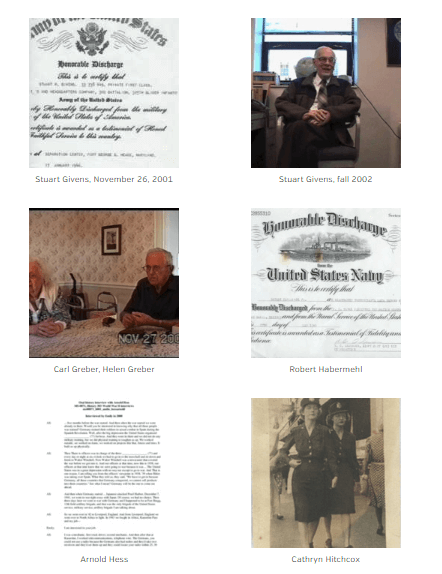
BGSU’s World War II veteran oral histories include both men and women. who served.
The project is part of a $6,700 grant the university received from the Ohio History Connection. A helpful finding aid is available for the collection here at the BGSU website.
You can search and view the interview here. If you’re like me, you’ll find these interviews with many of the Greatest Generation compelling to watch even if you don’t have relatives from Ohio.
Findmypast has added over 400,000 Donegal, Ireland records to their growing collection of Irish Workhouse records.
The Donegal Workhouses Registers and Minute Books have been digitized and published online for the first time by Findmypast in partnership with the Donegal County Council.
The records consist of both transcripts and images of original admission and discharge registers as well as board of guardians’ minute books spanning the years 1840 to 1922.
The collection covers the unions of:
As well as registers and minute books, users can also expect to find:
From Findmypast: “High levels of poverty in 19th century Ireland meant that hundreds of thousands of Irish people passed through the workhouses. Irish workhouses were generally built to accommodate around 800 inmates although it soon became clear that more space was needed and programme of building took place throughout the 1840s and 50s.
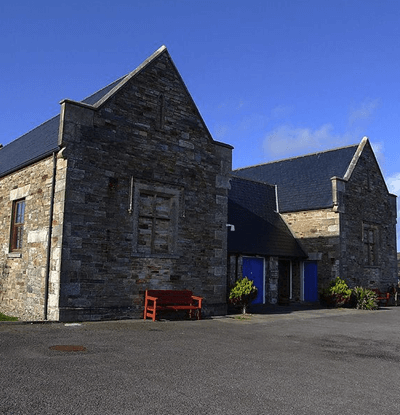
Former workhousein Dunfanaghy, Donegal Flickr user nz_willowherb [CC BY 2.0 (https://creativecommons.org/licenses/by/2.0)]
Life inside was grim. At first, there was no so-called outdoor relief, as would have been common in England. Outdoor relief was when the poor could simply use the workhouse facilities as needed by undertaking a day’s work. Indoor relief was initially the only option and required the poor to prove they were destitute before they were admitted.”
This new collection is part of an existing archive of Irish Workhouse records which now includes over 3.1 million records covering Dublin, Clare, Sligo and Waterford.
Findmypast has added 137,896 new pages to The Archive. These have been added to 18 existing publications spanning 128 years from 1871 to 1999.
The historical newspapers with new additions include:
Search these new records and images by clicking on the collection links below. The number shown in parenthesis is the number of indexed records added.
Australia: Australia, South Australia, Prison Records, 1838-1912 (81,971) New indexed records collection
Belgium: Belgium, Namur, Civil Registration, 1800-1912 (402) Added indexed records to existing collection
Canada: Nova Scotia Births, 1864-1877 (183,455) Added indexed records to an existing collection
Canada: Nova Scotia Marriages, 1864-1918 (18,885) Added indexed records to an existing collection
England: England, Herefordshire Bishop’s Transcripts, 1583-1898 (594,707) New indexed records collection
Germany: Germany, Saxony-Anhalt, Halberstadt, Civil Registration, 1874-1982 (12,060) Added indexed records to an existing collection
Lesotho: Lesotho, Evangelical Church Records, 1828-2005 (302) Added indexed records to an existing collection
Liberia: Liberia, Marriage Records, 1912-2015 (2,475) Added indexed records to an existing collection
Luxembourg: Luxembourg, Civil Registration, 1796-1941 (73,901) Added indexed records to an existing collection
Peru: Peru, Cemetery Records, 1912-2013 (42,164) New indexed records collection
Scotland: Scotland Presbyterian & Protestant Church Records, 1736-1990 (109,064) New indexed records collection
United States: Arkansas Confederate Pensions, 1901-1929 (33,779) Added indexed records to an existing collection
United States: Arkansas, Church Records, 1922-1977 (306) New indexed records collection
United States: California, Church Records, 1864-1985 1,941 New indexed records collection
United States: California, Santa Clara County, San Jose, Oak Hill Cemetery Headstone Inscriptions, 1838-1985 (61,966) New indexed record collection
United States: Colorado, Church Records, 1692-1942 (35,030) New indexed records collection
United States: Connecticut, Vital Records, Prior to 1850 (8) Added indexed records to existing collection
United States: Massachusetts, City of Boston Voter Registers, 1857-1920 (32,996) New indexed records collection
United States: Michigan, Civil War Centennial Observance Commission, Committee on Civil War Grave Registration, Burial Records (15,951) New indexed records collection
United States: Minnesota, County Deaths, 1850-2001 (8,672) Added indexed records to an existing collection
United States: Nebraska, Box Butte County, Funeral Home Records, 1919-1976 (3,491) Added indexed records to an existing collection
United States: Nebraska, Church Records, 1875-1899 (151) New indexed records collection
United States: Pennsylvania, Berks County, Reading, Charles Evans Cemetery and Crematory Burial Records, 1887-1979 (106,043) New indexed records collection
United States: Texas, Bexar County, San Antonio Cemetery Records, 1893-2007 (4,981) Added indexed records to an existing collection
United States: United States Deceased Physician File (AMA), 1864-1968 (78,215) Added indexed records to an existing collection
Did you find an ancestor or bust a brick wall using our list of new online genealogical records? Please leave a comment below and share your story and inspire others. And while you’re at it, please share this article using our social buttons (at the top of this article) with your genealogy friends. We thank you, and they will too!
